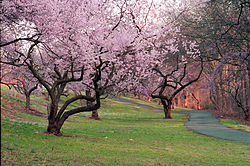Branch Brook Park
|
Branch Brook Park
|
|

Branch Brook Park and its cherry blossoms
|
|
| Location | Roughly bounded by Belleville Park, Washington and Clifton Avenues, 6th and Orange Streets, Newark and Belleville, New Jersey |
|---|---|
| Coordinates | 40°46′13″N 74°10′35″W / 40.77028°N 74.17639°WCoordinates: 40°46′13″N 74°10′35″W / 40.77028°N 74.17639°W |
| Area | 359.7 acres (145.6 ha) |
| Built | 1895 |
| Architectural style | Late Victorian, Other, French Renaissance |
| NRHP Reference # | 81000392 |
| Added to NRHP | January 12, 1981 |
Branch Brook Park is a county park of Essex County, New Jersey in the United States, located in the North Ward of Newark, between the neighborhoods of Forest Hill and Roseville. A portion of the park is also located within the Township of Belleville. At 360 acres (150 ha), Branch Brook Park is the largest public park in the city of Newark. The park is noted for the largest collection of cherry blossom trees in the United States, having over 4,300 in more than fourteen different varieties collectively called Cherryblossomland, as well as its spectacular Cherry Blossom Festival each April.
The park was formally created in 1895 by the newly created Essex County Parks Commission, making it the nation's first county park. The area had served as an Army training ground during the American Civil War. At the time, the northern portion of the area had been a marsh known as Old Blue Jay Swamp. In 1898, a public appropriation financed the conversion of the swamp into a landscaped lake. The initial park was only 60 acres (24 ha) in size but grew in the 1920s through private donations from prominent Newark families, such as the Ballantines, eventually reaching the city limit with Belleville and becoming one of the largest urban parks in the United States. The Morris Canal originally ran on the park's west side, until its old bed was turned into the Newark City Subway, providing access to the park from Downtown Newark.
The first designs of the park, based largely on romantic garden themes, were proposed in 1895 and 1898, after the Parks Commission hired several architectural firms to plan the park. In 1900, the commission hired the Olmsted Brothers firm to redesign the park. The result was the park's current naturalistic look and feel, with acres of meadows and forests, in a manner similar to their father's earlier designs of Central Park and Prospect Park.
...
Wikipedia



